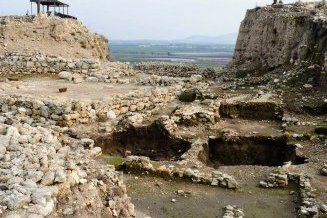
We visited all 3 Tels and didn’t find the “duplication” excessive – indeed the similarities and differences which emerged were of benefit in understanding the entire nomination. We gave Megiddo just over an hour – but ideally it needed more. Like the previous reviewer we came up against the “dragon at the desk”! We were early enough to get in but it was Shabbat and it was made clear that, even if the official closing time was 3pm, they really wanted us out at 2.45. Also the Water Tunnel closed at 2.30. Hazor took 50 minutes (but the water system unfortunately was closed because of roof falls – who knows when it will reopen). Finally, Beersheba took about an hour – but that was extended by our conversation with one of the young volunteers working on the site.
There are 2 background issues concerning these sites which it is perhaps worth bringing out at this point
a. They were originally nominated on 2 different sets of criteria. For their “Biblical Associations” under ii, iii, iv and vi and for their “Water Systems” under i, ii and iii. During the evaluation Israel asked that this second set not be considered and agreed to change the nominated name from “The Biblical Tels and Ancient Water Systems of …” to merely “The Biblical Tels of …”. Why this happened isn’t made clear in the AB evaluation. The Water systems do however represent a major aspect of what is “on show”
b. Israel has indicated that it might want to add yet more Tels to the inscription and a map in the Nomination File shows another 7 – including our “old friend” Tel Dan which has of course been (unsuccessfully) pursuing a separate nomination for just the Triple Arch Gate element of the Tel. The AB evaluation states that Israel was asked to justify further its choice of just the 3 Tels nominated but I haven’t been able to access its response. In any case, ICOMOS recorded that it “Encourages the State Party to explore the possibility of adding further tels to widen the serial nomination in the future”. Noriceably, of the other 6 only Beit She’an is represented on Israel’s T List and that for its entire aspect from Tel to Roman City
So, what can you see at each site? Briefly
a. Megiddo. If you can only see 1 then this I guess is the one to see. In fact its most important aspects are those of a Bronze Age Canaanite city and the later Israelite remains are much less significant. The Water system which we had to rush to see consists of a 70 metre long tunnel down some 30 metres of steps. The “visit” is designed such that you exit the tunnel by a lower series of steps just beyond the Tel where you leave the site altogether to be picked up by your tour bus which will have driven to await you!! Alternatively you walk along a road outside the site back to your car. Neither of these options suited us at all as we wished to make full use of our constrained time by revisiting all the site’s elements so we returned along the tunnel and re-climbed the deeper steps! Another noteworthy aspect of the site is the enormous “cut” created by the Rockefeller-funded excavations of the 1920s/30s (Photo). This was "industrialised" archaeology!
b. Hazor. This is primarily another Bronze Age Canaanite site with some Iron Age Israelite elements. One element of note is the Canaanite (??) Cultic area with its stelum or “Massebah” (“You shall not erect a massebah that Yahweh your lord hates" - Deuteronomy 16:22). I would be interested in anyone commenting on the Forum about the Bible’s attitude towards “Masseboth” (plural!) as, from my limited investigations and understanding, it seems rather contradictory.
c. Beersheba. A “genuine” Israelite settlement from the Iron Age. If it is another “Tel” there must be another “Water System” - and indeed there is! For this one you are required to pick up a “hard hat” to protect you as you wend your way through the twisting tunnels. Apart from that this site is perhaps the least interesting of the 3.
More on
Comments
No comments yet.
